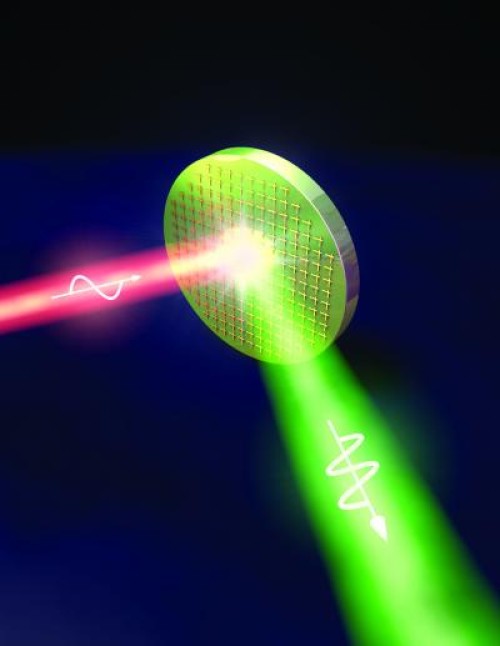
Researchers at the Cockrell School of Engineering at The University of Texas at Austin have created a new nonlinear metasurface, or meta mirror, that could one day enable the miniaturization of laser systems.
 The invention, called a "nonlinear mirror" by the researchers, could help advance nonlinear laser systems that are used for chemical sensing, explosives detection, biomedical research and potentially many other applications. The researchers' study will be published in the July 3 issue of Nature.
The invention, called a "nonlinear mirror" by the researchers, could help advance nonlinear laser systems that are used for chemical sensing, explosives detection, biomedical research and potentially many other applications. The researchers' study will be published in the July 3 issue of Nature.
The metamaterials were created with nonlinear optical response a million times as strong as traditional nonlinear materials and demonstrated frequency conversion in films 100 times as thin as human hair using light intensity comparable with that of a laser pointer.
Nonlinear optical effects are widely used by engineers and scientists to generate new light frequencies, perform laser diagnostics and advance quantum computing. Due to the small extent of optical nonlinearity in naturally occurring materials, high light intensities and long propagation distances in nonlinear crystals are typically required to produce detectable nonlinear optical effects.
The research team led by UT Austin's Department of Electrical and Computer Engineering professors Mikhail Belkin and Andrea Alu, in collaboration with colleagues from the Technical University of Munich, has created thin-film nonlinear metamaterials with optical response many orders of magnitude larger than that of traditional nonlinear materials. The scientists demonstrated this functionality by realizing a 400-nanometer-thick nonlinear mirror that reflects radiation at twice the input light frequency. For the given input intensity and structure thickness, the new nonlinear metamaterial produces approximately 1 million times larger frequency-doubled output, compared with similar structures based on conventional materials.
"This work opens a new paradigm in nonlinear optics by exploiting the unique combination of exotic wave interaction in metamaterials and of quantum engineering in semiconductors," said Professor Andrea Alu.
The metamaterial at the basis of this unusual optical response consists of a sequence of thin layers made of indium, gallium and arsenic on the one hand and aluminum, indium and arsenic on the other. The researchers stacked approximately 100 of these layers, each between 1 nanometer and 12 nanometers thick, and sandwiched them between a layer of gold at the bottom and a pattern of asymmetric gold nanocrosses on top. The thin semiconductor layers confine electrons into desired quantum states, and gold nanocrosses resonate at input and output frequencies to enable the the nonlinear optical response of the mirror.
The realized mirror converts light from a wavelength of 8 micrometers to 4 micrometers; however, the structures can be tailored to work at other wavelengths, from near-infrared to mid-infrared to terahertz.
"Alongside frequency doubling, our structures may be designed for sum- or difference-frequency generation, as well as a variety of four-wave mixing processes," said UT Austin graduate student Jongwon Lee, the lead author on the paper.
"Our work unveils a pathway towards the development of ultrathin, highly nonlinear optical elements for efficient frequency conversion that will operate without stringent phase-matching constraints of bulk nonlinear crystals," said Professor Mikhail Belkin.

 Previous page
Previous page Back to top
Back to top







